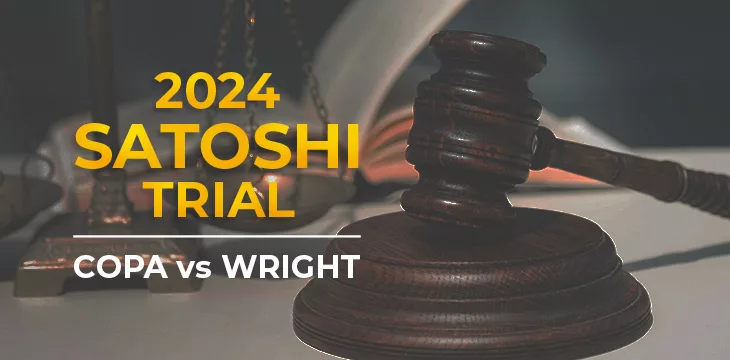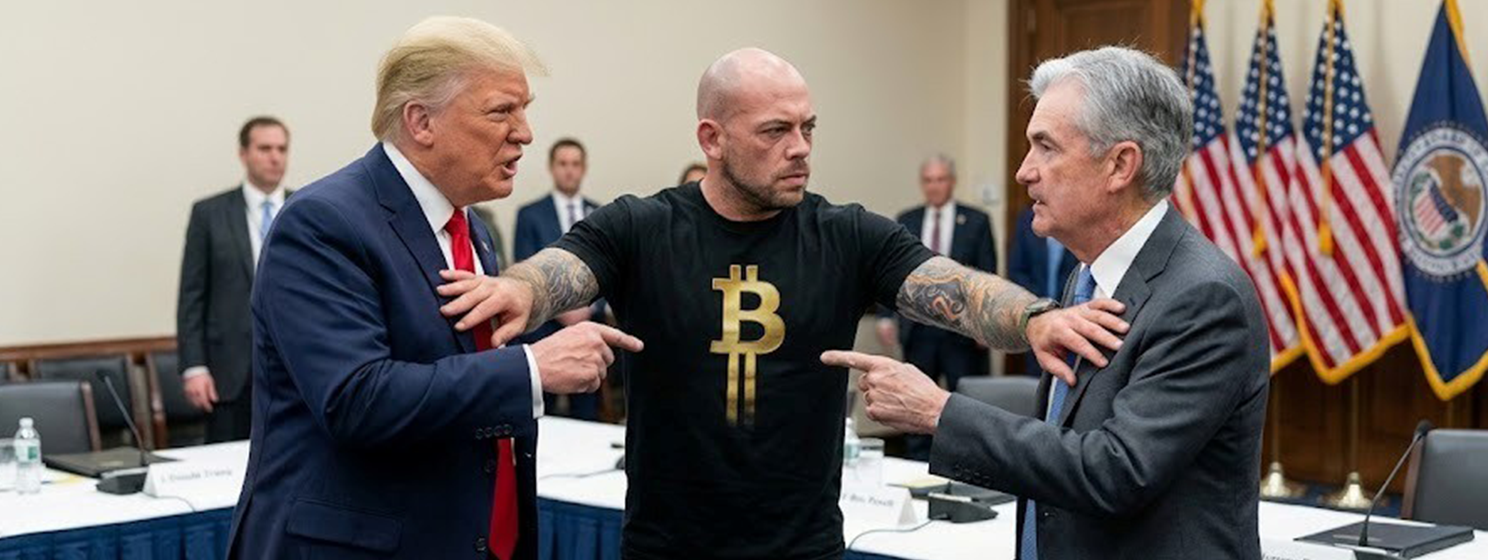|
Getting your Trinity Audio player ready...
|
As the fourth week of the Crypto Open Patent Alliance (COPA) v Dr. Craig Wright trial draws to a close, the court heard the final testimony and cross examination of witnesses. Next week the court—and those of us that have been in attendance watching the drama unfold every day for the last four weeks—will rest before closing arguments start back up on March 12.
With this in mind, it seems an appropriate time to look back at some of the sights and sounds of the landmark trial, in which the Crypto Open Patent Alliance (COPA), a loose collection of—predominately—big U.S. tech interests, including the likes of Coinbase (NASDAQ: COIN), Kraken and formerly Meta, is suing Australian-born computer scientist Dr. Wright over his claim to be the pseudonymous creator of Bitcoin, Satoshi Nakamoto—a claim COPA refutes.
Specifically, the question before the court is “whether Dr. Wright is the pseudonymous “Satoshi Nakamoto”, i.e. the person who created Bitcoin in 2009.”
After a day of opening arguments, an exhausting nine days for Dr. Wright on the stand, and a couple of weeks of witness cross examination, the outcome of the trial remains very much in the balance, with much on the line.
A win for COPA would potentially settle several other pending cases, including a copyright infringement claim Dr. Wright has against the BTC Core Developers; a win for Dr. Wright would, in many ways, be more groundbreaking, potentially resulting in BTC no longer being able to call itself Bitcoin and the Core Developers likely having to pay Wright for the use of patents derived from the file format and White Paper.
With all that’s at stake, you could feel the cracking intensity in the packed room as the trial kicked off on February 5. Of course, that could have just been related to the tropical temperatures in Court 30 of the U.K. High Court Rolls building, where the air conditioning has been offline since a power failure last Christmas.
As such the ‘super-court’ where the trial is taking place, so called because it’s one of the largest in the building, was punishingly hot and oppressive, a fact that was only exacerbated by the early throngs of observers. The first few days saw queues outside the room in the morning for supporters, journalists and interested joe publics, of which there are many.
Thirty-odd computers and about 40-50 people crammed into the court room in the first few days, so many that an overflow room was required for the early stages of the trial. This only added to the heat in the room—metaphorical and literal.
This heat (the latter form at least) didn’t go unnoticed by Judge James Mellor, who is overseeing the case and will ultimately decide the outcome. Luckily, for those of us determined to stick it out every day Mellor managed to get proceedings switched in the second week of the trail to Court 26, a larger and better air-conditioned room.
As the setting moved on so—seemingly—did the general enthusiasm of the audience to be there in person, and by week two observers had petered out to a few hardcore interested parties on each side of the fence. Despite the drop in attendance, interest in the trial itself only seemed to grow, and by week four Mellor announced that 950 people were viewing the live stream.
Video streams are not for everyone through. For me, there is something theatrical about Court proceedings. The speeches, the performances, the twists and turns, the heroes and villains; the drama of it all. And like all great theatre, I believe it is best experienced live and in person. So here are some sights and sounds from the play so far, as seen from inside the theatre—as Shakespeare intended.
The key players on the stage
Despite the tropical heat of week one, the key man and de facto defendant in the case, Dr. Wright, remained remarkably cool-headed throughout most of his testimony and the extensive, methodical questioning by COPA’s lead barrister—at one point attributing this to several years of anger management classes.
Throughout his nine days of cross examination (eight initial days and a day’s return to the stand to answer questions on a report produced during the trial) Dr. Wright also treated the court to a string of pristine three-piece suits, a new one each day. His claim to be the most elegantly dressed in court was only challenged briefly in week four by COPA expert witness Arthur Rosendahl, who turned up in a trilby and enormous bowtie—a great combo if you ask me.
As it happened, Rosenthal’s cool attire also matched his demeanor—perhaps there’s a fashion-mood correlation worth exploring there.
While Wright might have the titular role in this play, the most important actor is arguably Judge Mellor. He exudes calm authority and intelligence, only occasionally piping up, and when he does it’s almost always to ask the burning question or seek the right clarification. His engineering background no doubt helps in this regard.
When it comes to the barristers, opinions seemed to be split amongst observers on the relative competence and styles of the two leads, Jonathan Hough KC for COPA and Lord Grabiner KC for Dr. Wright—for those not familiar with the U.K. legal system, KC is an acronym for ‘King’s Council,’ an honorary title given to experienced barristers (lawyers who specialize in representing clients in court).
Lord Grabiner began his cross examinations of COPA witnesses in week three. An imposing inquisitor, he was always quick to jump on any inconsistency or lack of clarity in witnesses’ answers, drilling down on points until you could almost feel the poor recipient’s tooth fillings shaking loose. There are times just being in the same room during Grabiner’s relatively brief cross examinations gives you secondhand stress.
Mike Hearn got a particularly rough ride from Grabiner. His short 30-minute cross examination of the former Bitcoin developer left me questioning the veracity of key memories from my own life—did I really meet Richard Attenborough when I was 21 or was it just a guy who looked a bit like Santa. I better find the receipts in case I ever drop that anecdote at a dinner party Grabiner is also attending.
This forceful style makes Grabiner the perfect foil for Dr. Wright’s other barrister, Craig Orr KC, who is every bit the good cop to Grabiner’s bad cop.
Orr took a much more melodic approach, serene even, by comparison. He calmly and methodically established facts and unraveled inconsistencies, seemingly working through things with witnesses until he suddenly got to his point, and they realized he’s not their friend.
This is not to say Orr can’t turn up the pressure, he certainly borrowed Grabiner’s bad cop cap for the cross examination of COPA’s expert witness Mr. Patrick Madden. The poor forensic analysist looked shell shocked after Orr was through questioning him about his working arrangements with COPA solicitors Bird & Bird.
However, across the aisle are also two formidable lead barristers.
Hough KC seems to divide opinion, with commentors’ assessments on X (formerly Twitter) ranging from methodical and detailed, to completely incompetent, depending on who you asked. For my part, Hough came off as the definition of competence, with his measured, detailed, and comprehensive approach to cross examination and laying out his case.
Alexander Gunning KC appeared on behalf of the BTC Core Developers, who are facing their own suit from Dr. Wright but agreed to be bound by the results of this trial with regards to the ‘Satoshi question.’
Gunning’s approach has garnered praise and respect from both sides of the debate. He has a clear knack for the lost art of rhetoric but is equally on top of the technical details—he is representing developers so perhaps that makes sense.
His second cross examination of Dr. Wright, on day 15 of the trial, was a particularly barnstorming display, leading to many vocal COPA supporters, perhaps prematurely, fist pumping the air and singing Gunning’s praises.
With all these titans of the legal stage strutting around and hamming it up, it’s perhaps easy to forget what real world impacts the result of the trial could have on the ordinary, ‘little people,’ in the digital asset space around the globe.
That’s why it was interesting to see a slightly odd sideshow in week three, when a Mr. Paul Lamb, a digital asset developer working on what he described as an “improved” version of bitcoin called ‘hotcoin,’ attempted to join his name to the COPA case.
This attempted joining mid-trial was against COPA’s wishes and quite irregular, but clearly Lamb had jumped through the appropriate bureaucratic hoops and so Judge Mellor heard him out.
As well as joining the COPA side of the case, Lamb wanted Mellor to assert that whatever the outcome of the trial there remains an element of doubt—so it’s easy to see why COPA weren’t enthusiastically embracing their potential new ally.
Ultimately, Lamb’s application to join the trial was dismissed, but the interlude did at least provide a valuable example of the ordinary people developing or invested in the digital asset space that could be impacted by the outcome, one way or another—not just the faceless big tech companies that make up COPA’s membership.
A strange setting for healthy debate
Another oddity of the much anticipated and divisive Satoshi Trial was the tenor of debate within and around the court room.
With the overheating court, the packed room, and the high stakes, you might expect attendees of the trial, who were largely a collection of supporters of one side or the other with a spattering of neutral observers, to be at each other’s throats at every opportunity and coffee break.
However, this was surprisingly not the case, at least in person.
In and outside of the court it was buzzing with chat, discussion, introductions, and exchanges of ideas, as well as a bit of gossip and speculation. Naturally, lots of the talk revolved around Bitcoin, BTC and BSV.
Dr. Wright was a key figure in the creation of Bitcoin Satoshi Vision (BSV). And if Wright is proved to be Satoshi Nakamoto, he would also undoubtably be the key figure in the creation of Bitcoin full stop.
Anyone, no matter what their favorite flavor of Bitcoin, would be hard pressed not to notice the general toxicity of the online debate around BTC vs BSV, small block vs big block. This is not necessarily unusual, the tone of pretty much any debate online, particularly on X (Twitter), often descends into vitriol—if it didn’t already start out way.
This makes it all more heartening that despite the acrimonious nature of the Satoshi Trial, the U.K. High Court became the surprising venue for some of most genial and good-natured discussions on all things digital assets that I’ve heard of late.
One such example, overheard in a short court break in week one, was a jovial exchange between a self-avowed Dr. Wright believer and BSV supporter, and a BTC developer.
After politely discussing various applications and what each was working on, the latter jokingly told the former they should “come over from the dark side.” To which the former replied, “well it (BSV) just works for me. If he (Wright) loses, I’ll accept that he’s not Satoshi, but I can’t accept BTC because it doesn’t work.”
In the end both agreed that they were happy with their choice and went off to have a coffee together. No drama, no mud flung, no death threats or accusations of cult-hood.
This was just one short snippet, of one conversation, of which there were many more such agreeable exchanges between would-be philosophical and technological opponents overheard during my seventeen days at the Satoshi Trial.
This pleasant irony is worth keeping in mind if you choose to follow the rest of the trial—either virtually or in person—and when mulling over Judge Mellor’s eventually decision: that the COPA vs Wright case, with all its potentially transformative implications for the blockchain space, would end up being the most unlikely of settings for some of the best-mannered and constructive BSV-BTC debates around.
I guess dedicated theater goers know, drama is best left for the stage.
Check out all of the CoinGeek’s special reports on the Satoshi Trial (COPA v Wright).

 01-17-2026
01-17-2026 




